TO MY BELOVED TEACHER, B.K.S. IYENGAR
In 1973 I was a young man wandering in India, seeking answers. I had heard of Mr. Iyengar and had done every pose in his book as well as I could, twice daily, for about a year. I was also contemplating becoming a doctor.
I arrived in Pune at siesta time. I went to Mr. Iyengars house and knocked on his door. To my surprise, he opened it.
What do you want? he demanded rather grumpily.
I want to learn your yoga.
Because I want to heal, I blurted out.
Thats my great thing! he said. Come in.
My debt to Mr. Iyengar extends beyond words. However, it must be stated that I (and not he) am responsible for everything in the text
CONTENTS
Yoga and Back Pain
What Is Yoga and Why Yoga for Back Pain?
Pain
Poses by Diagnosis
Herniated Nucleus Pulposis
(Herniated Disc, Pinched Nerve Root)
g
NOTE TO READERS
This book is not a substitute for medical advice and assistance. The judgment of individual therapists and physicians who know you is essential. It is in this setting of personal, expert attention that yoga was developed, and the setting for which it has always been intended.
ACKNOWLEDGMENTS
We would like to thank the many friends and professionals who contributed medical, yoga, and editorial advice to this book. Tova Ovadia, PT; Carole Lewis, PT, PhD; Caroline Konnoth, PT; Barry Pinchoff, MD; James Dillard, MD; and Donald Cohen, MD, have stimulated our thought and made invaluable suggestions.
Christine Saudek, MS, PT, and certified senior Iyengar yoga teacher, shared her expertise, reading our manuscript for accuracy during the final stages of writing and revision, asking difficult questions and attending to every detail.
Experts in yoga and alternative medicine have been generous with their time and ideas. Special thanks are due to Sally Hess, model par excellence, for her patience and tireless technical and editorial work. We are also grateful to Mary Dunn, Ellen Saltenstall, Joan White, Victor Oppenheimer, Leslie Kaminoff (the Breathing Project, New York City), Pamela Miles (Institute for the Advancement of Complementary Therapies), Eric Small, Sheldon Lewis, Paul Frediani (Sports Athletics), Ellen Peterman, Jon Keller, and Vidya Albrink.
For editorial help and general support without which this book would not have been possible, we would like to express our gratitude to Amy Hertz, Ellen Levine, Jill Bialosky, Jane Bernstein, Warren Sidall, Tom Murtha, Mark Rudman, Eileen Stukane, Sheila Weller, and John Cooney.
PART I
Yoga
and
Back Pain


CHAPTER 1
What Is Yoga and
Why Yoga for
Back Pain?
M any people experience back pain from time to time. Whether this pain is severe and chronic or mild and short-lived, it often causes misery and curtails everyday activities. Why practice yoga for back pain? Yoga has been associated with healing through the millennia. It is without cost, self-administered, and silent, and it demands no equipment beyond a pillow, a belt, or a chair. Yoga relieves pain and promotes calm to endure any pain that remains. It can address back pain generally, through prevention, and directly with attention to the specific cause of existing pain. No special beliefs are required in the practice of yoga.
What Is Yoga?
Yoga means yoke (a link, a harness that joins together) or unity. This unity refers to the oneness of body and mind. The purpose of yoga is to bring together the body and mind to create harmony, or well-being. The word yoga also means discipline or effort.
Some people think of yoga as an art; others call it a science. Most would agree that although it is associated with Hinduism, it is a secular practice that can be done by individuals of any faith or no faith. I like to think of yoga as a system of behavior that encompasses mankinds social context; that is, it exists in a social environment, influencing and being influenced by the community around it. Certainly yoga has gathered devoted practitioners from many different faiths and lands.
The classical form of yoga has eight limbs, or branches, the first two of which are relevant for anyone who considers using yoga to aid in the healing process, to relieve back pain or any other type of pain.
Universal moral commandments having to do with our relations with others, called Yama, constitute the first limb. These are concerned with nonviolence, truthfulness, not stealing, temperance, and noncovetousness. The second limb of yoga, Niyama, contains individual moral directives, including purity, contentment, austerity, introspection, and dedication to a higher being.
There is no question in my mind that Yama and Niyama serve the purpose of anyone seeking healing. Following these codesliving an uncomplicated life, with dignity, purpose, and compassionis very strong medicine. As the gyroscopes internal motion resists deflecting influence, reasonably disciplined striving toward personal improvement creates its own momentum.
Asanas, or postures, make up the third limb of yoga. In the West, these positionslotus position, headstand, and so onare typically identified with yoga. Hatha (physical) yoga is made up of asanas. When I was in India, Mr. Iyengar demonstrated various asanas for his classes; these poses had been practiced and refined for thousands of years. Within the various schools of yoga, the style of these asanas differs; also, some poses are still evolving. Some asanas have biological names based on the gestalt of the position. The Tree and the Scorpion are examples of these. Others are named for their attitude, for example, after gods in Hindu mythology: Hanumanasana or Virabhadrasana. A third group of asanas is known for the anatomical parts that figure most prominently in their execution, such as the headstand or arm balance.
The fourth limb is Pranayama, which concerns the apparatus and technique of breathing. This practice is used in a number of respiratory and psychiatric conditions but also to help the student progress beyond mere physical health and toward a state of liberation. Many yogis believe that breathing is the bridge between the body and the soul.
Pratyahara, control of the senses (desires), is the fifth limb . Dharana, the sixth limb, focuses an individuals mind and promotes concentration. Next, Dhyana is a blissful state in which one selflessly devotes ones time and energy to seeing the spiritual essences and giving all of ones resources for the betterment of the world. Finally, Samadhi is the attainment of liberation or enlightenment.
In the type of yoga you will likely be practicing, the yogi frees himself from physical disabilities and mental distractions by practicing asanas, as Mr. Iyengar wrote in his classic book, Light on Yoga. It isnt an accident that one of the first textbooks on yoga was written by Patanjali, who lived thousands of years ago and is believed to have been a physician.


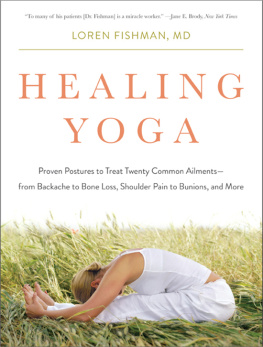


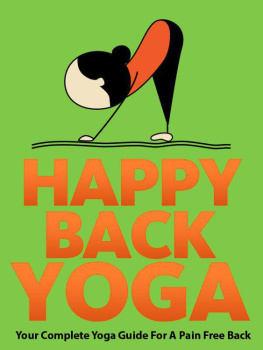
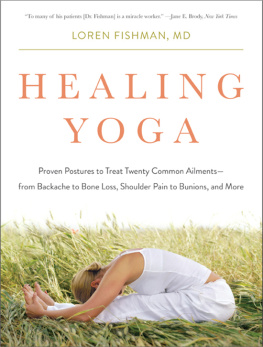
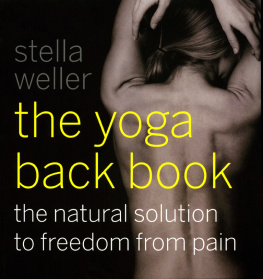
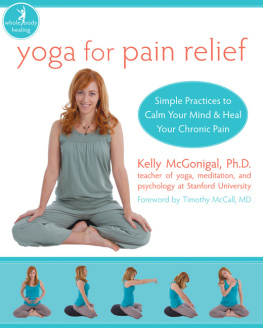

 W. W. Norton & Company
W. W. Norton & Company
